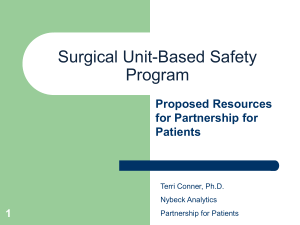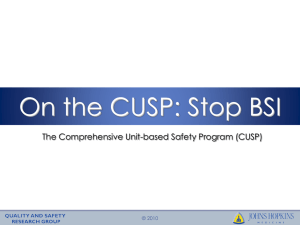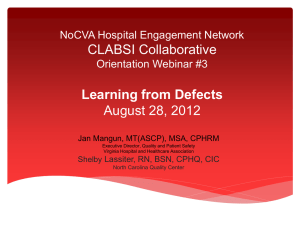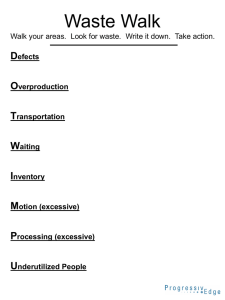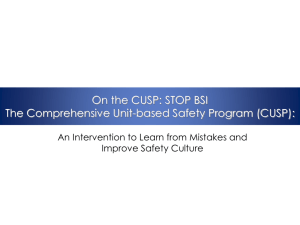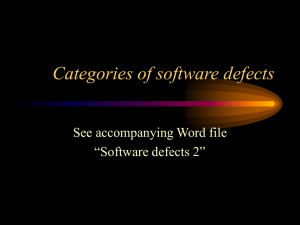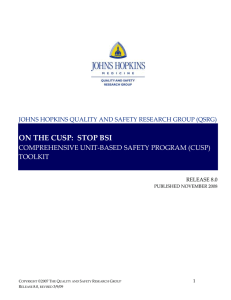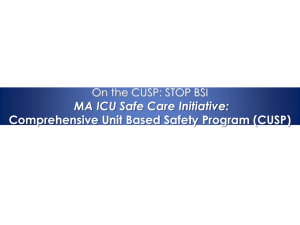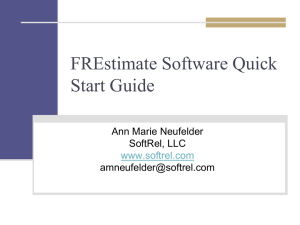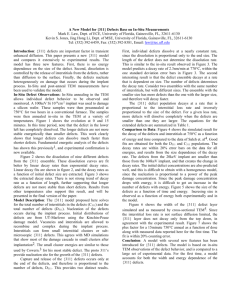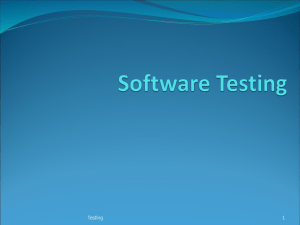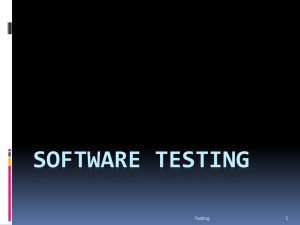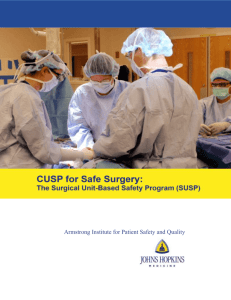Central Line Associated Blood Stream Infections (CLABSI)
advertisement
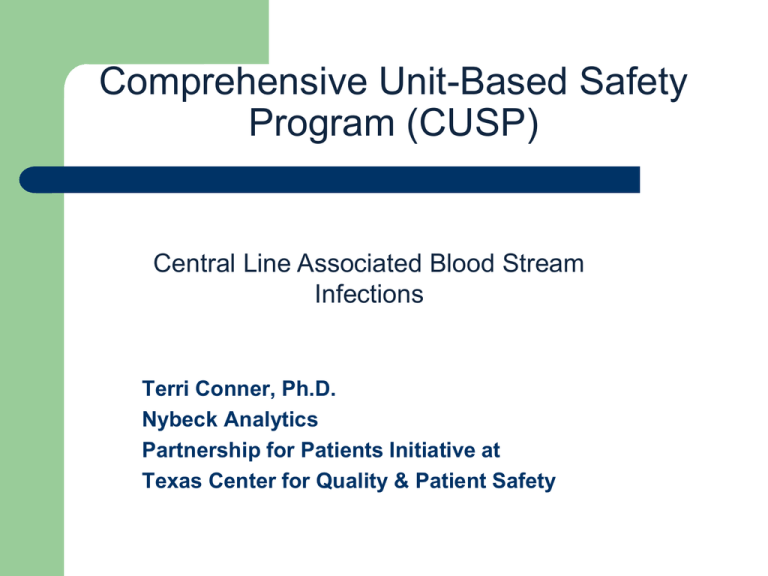
Comprehensive Unit-Based Safety Program (CUSP) Central Line Associated Blood Stream Infections Terri Conner, Ph.D. Nybeck Analytics Partnership for Patients Initiative at Texas Center for Quality & Patient Safety GOALS Work to eliminate central-line associated blood stream infections (CLABSI) in your unit Improve safety culture Learn from defects EVIDENCE-BASED BEHAVIORS TO PREVENT CLABSI Remove unnecessary lines Wash hands prior to procedure Use maximal barrier precautions Clean skin with chlorhexidine Avoid femoral lines 4E’S TO ENSURING PATIENTS RECEIVE EVIDENCE Engage – How does this make the world a better place? Educate – What do we need to know? Execute – What do we need to do? – What keeps me from doing it? – How can we do it with our resources and culture? Evaluate – How do we know we improved safety? ENGAGE CLABSIs associated with significant morbidity, mortality, and costs Patients in ICUs are at an increased risk – – – 48% of ICU patients have indwelling central venous catheters 15 million central line days per year in United States ICUs As many as 28,000 ICU patients die from CLABSIs annually in the U.S. alone. ENGAGE Share about a patient who was infected Post baseline rates of infections Estimate number of deaths and dollars from current infection rates Remind staff that most CLABSI are preventable EDUCATE Conduct in-service regarding CLABSI prevention Create forum to jointly educate physicians and nurses Add CLABSI prevention to ICU orientation Give staff fact sheets, articles, and slides of evidence EXECUTE Standardize and reduce complexity: Create line cart Create independent checks: Create BSI checklist Ask providers daily whether catheters could be removed Empower nurses to ensure physicians comply with checklist – Nurses can stop takeoff Learn from mistakes: review every infection EVALUATE Monitor rates of infections using CDC definitions Post rates of infections per year in the unit Post number of weeks or months without an infection CUSP Comprehensive Unit-based Safety Program An intervention to learn from mistakes and improve safety culture A good approach whenever there is a gap between evidence-based practice and current practice on your unit. CUSP: EMPHASIS ON CULTURE Shared attitudes, values, goals, practices, behaviors Culture influences behavior – Participation in quality improvement efforts – Communication Breakdown in communication contributes to nearly all adverse events. CUSP: COMPREHENSIVE UNITBASED SAFETY PROGRAM Safety practices part of daily work Implemented at the unit level Led by clinicians Structured program, yet flexible PRE-CUSP STEPS Assemble Safety Team – Multidisciplinary – Different levels of experience – Encourage joining team at any phase of the program PRE-CUSP STEPS Team Members – – – – – – – Project Leader (Unit Champion) Nurse Manager Physician Champion Senior Hospital Executive Patient Safety Coordinator Epidemiology / Infection Control Coach PRE-CUSP STEPS Measure Safety Culture – Before CUSP implementation, and then every 12-18 months – Use AHRQ’s The Hospital Survey on Patient Safety Culture (HSOPS) – All clinical and non-clinical providers – Report results to the unit and senior hospital executive CUSP STEPS 1. Science of safety training 2. Identify defects 3. Assign executive to adopt unit 4. Learn from defects 5. Implement teamwork tools STEP 1: SCIENCE OF SAFETY TRAINING Goals – Magnitude of patient safety problem – Foundation for investigating safety defects – Providers’ involvement significantly affects patient safety STEP 1: SCIENCE OF SAFETY TRAINING Learning Objectives – Safety is a property of the system – Use strategies to improve system performance Standardize work Create independent checks for key processes Learn from mistakes – Apply strategies to both technical work and team work – Teams make wise decisions with diverse and independent input STEP 1: SCIENCE OF SAFETY TRAINING Training Session – 3-part “Improving Safety” presentation by Dr. Peter Pronovost – Part 1: http://www.youtube.com/watch?v=GOJJHHm7lnM Part 2 http://www.youtube.com/watch?v=wpzb7nM6oFQ&feature=rela ted Part 3 http://www.youtube.com/watch?v=6BnXs4KtER8&feature=relat ed Instruct staff on reporting of safety concerns STEP 2: IDENTIFY DEFECTS Eyes and ears of patient safety Ongoing process Disseminate Staff Safety Assessment Form Combine results and prioritize defects WHAT IS A DEFECT? Anything you do not want to have happen again. Blood stream infections are almost always preventable. They should be viewed as defects. STEP 2: IDENTIFY DEFECTS Staff Safety Assessment Form – Purpose: Tap into your knowledge and experiences at the frontlines of patient care to find out what risks are present on your unit that do or could jeopardize patient safety. – All health care providers in the unit complete this form. – 2-item questionnaire STEP 2: IDENTIFY DEFECTS Staff Safety Assessment Form 1. Please describe how you think the next patient in your unit/clinical area will be harmed. 2. Please describe what you think can be done to prevent or minimize this harm. STEP 2: IDENTIFY DEFECTS Combine Results – – Group into common types of defects Communication Medication process Patient falls Supplies Frequency distributions Example: communication, 57% STEP 2: IDENTIFY DEFECTS Prioritize safety concerns – Obtain input from CUSP team senior executive – Prioritize based on Likelihood of causing patient harm Severity of harm How common is the problem Likelihood it can be solved by implementing a daily work process STEP 4: LEARN FROM DEFECTS Four Key Questions 1. What happened? 2. Why did it happen? 3. What will you do to reduce the chance it will recur? 4. How do you know that you reduced the risk that it will happen again? WHAT HAPPENED? Reconstruct the timeline and explain what happened Put yourself in the place of those involved, in the middle of the event as it was unfolding Try to understand what they were thinking and the reasoning behind their actions/decisions Try to view the world as they did when the event occurred WHY DID IT HAPPEN? SYSTEM FAILURES Arise from managerial and organizational decisions that shape working conditions Often results from production pressures Damaging consequences may not be evident until a “triggering event” occurs Develop lenses to see the system factors that lead to the event WHAT WILL YOU DO TO REDUCE THE RISK OF IT HAPPENING AGAIN? Prioritize most important contributing factors Prioritize most beneficial interventions Safe design principles – Standardize what we do – Create independent check – Make it visible Safe design applies to technical and team work WHAT WILL YOU DO TO REDUCE THE RISK OF IT HAPPENING AGAIN? Develop list of interventions For each intervention: – Rate how well the intervention solves the problem or mitigates the contributing factors for the accident – Rate the team belief that the intervention will be implemented and executed as intended Select top interventions (2 to 5) and develop intervention plan – Assign person, task follow-up date HOW DO YOU KNOW RISKS WERE REDUCED? Did you create a policy or procedure? Do staff know about policy or procedure? Are staff using the procedure as intended? – Behavior observations, audits Do staff believe risks were reduced? STEP 4: LEARN FROM DEFECTS Summarize and Share Findings – Learning from Defects Tool – – Detailed form for each incident or identified defect Case Summary Form Summarize the case Identify system failures Identify opportunities for improvement List actions taken to prevent future harm Share your findings EXAMPLES Defect: Nasoduodenal tube placed in lung Intervention: Protocol developed for NDT placement Defect: Bronchoscopy cart missing equipment Intervention: Checklist developed for stocking cart Defect: Inconsistent use of Daily Goals rounding tool. Intervention: Gained consensus on required elements of Daily Goals rounding tool. STEP 4: LEARNING FROM DEFECTS Key Points – Focus on systems, not people – Prioritize – Go mile deep and inch wide, rather than mile wise and inch deep – Pilot test – Learn from 1 defect a quarter – Answer the four questions STEP 5: TEAM WORK TOOLS Staff Safety Assessment Safety Issues Worksheet Status of Safety Issues Learning from Defects Tool Case Summary Form Daily Goals Checklist Morning Briefing Tool Shadowing Another Professional Observing Rounds STAFF SAFETY ASSESSMENT Used to identify defects in the unit 1.Please describe how you think the next patient in your unit/clinical area will be harmed. 2.Please describe what you think can be done to prevent or minimize this harm. SAFETY ISSUES WORKSHEET Identified Issue 1. 2. 3. Potential/ Recommended Solution Resourc es Needed Resources Not Needed STATUS OF SAFETY ISSUES New and Ongoing Date Date Safety Issue Safety Issue Contact New and Ongoing Contact Status Status Goal Goal Completed Date Safety Issue Contact Status Goal LEARNING FROM DEFECTS Explain what happened. Check off the factors that negatively or positively contributed to the incident. Describe how you will reduce the likelihood of this defect happening again by completing the tables. Develop interventions, and choose 2-5 to implement. – What will be done? – Who will lead the intervention? – When is follow-up? Describe how you know you have reduced the risk. Summarize your findings using the Case Summary Form. CASE SUMMARY FORM Form Sections Safety tips Case summary System failures Opportunities Actions for improvement taken to prevent harm DAILY GOALS CHECKLIST Care plan for patients Lists needs for the day to safely move a patient closer to discharge Used to improve communication among care team members and family members. Use during morning and evening rounds, and kept at patient’s bedside. Adapt to your own unit’s environment. MORNING BRIEFING TOOL Structured approach to assist physicians and charge nurses in identifying the problems that occurred during the night and potential problems during the clinical day. Tool used by: – Physicians who conduct patient rounds – Charge nurses and nurse managers who make patient assignments Complete this tool daily prior to starting patient care rounds by meeting with the charge nurse. SHADOWING ANOTHER PROFESSIONAL Designed to provide a structured approach to identify communication, collaboration and teamwork defects among different practice domains. Purpose: to improve teamwork, collaboration, and communication that affect patient care delivery Who should use this tool? – Anyone on the CUSP team – Staff unfamiliar with responsibilities and practice domains of another profession – Executive team member may want to shadow practitioners Recommended when <60% of unit members report good teamwork or good safety climate. OBSERVING ROUNDS Purpose: Provide a structured approach for improving teamwork, and communication behaviors across and between disciplines that negatively affect staff morale and patient care delivery. Who Should Use this Tool? – Physicians who conduct patient rounds. – Administrators, house officers, nurses, pharmacists, respiratory therapists, medical and nursing students better understand the dynamics of multidisciplinary rounds identify defects in communication foster collaboration among disciplines or practice domains target areas where communication can be improved in the rounding process and in setting patient daily goals CUSP IS A CONTINUOUS JOURNEY! THANK YOU
